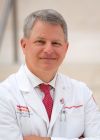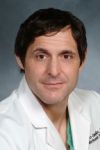An aortic aneurysm is an enlargement or dilatation of a part of the body's major blood vessel, the aorta, which is responsible for carrying blood to the entire body. Aortic aneurysms tend to slowly grow over time. If the aorta becomes too large, it may be at higher risk for rupturing (bursting) or tearing (aortic dissection), requiring emergency surgery to repair it. We aim to find and repair these aneurysms before these emergencies occur to reduce the risk to our patients as much as possible.
The repair of aortic aneurysms requires exceptional skill and experience. The Weill Cornell Cardiothoracic surgeons have extraordinary expertise in this area and we are one of the largest aortic surgery centers in the region and the country. We are particularly experienced in patients who have other complex health problems and those who are elderly. Our surgeons have achieved excellent outcomes — among the best in the nation — with a very low rate of complications.
The key to this success is a team approach that brings together all of the experts required for a patient's care. In addition to experienced cardiac surgeons, our team includes interventional radiologists, anesthesiologists, critical care specialists, and dedicated nurses with specialized experience caring for patients with aneurysms. This is especially important for patients who may have other healthcare problems, such as diabetes, hypertension, kidney problems and pulmonary disease which need to be addressed. Our surgeons are doctors who look at the complete patient, providing comprehensive care to treat the patient as a whole — not just the part we are operating on.
Aneurysms of the aorta can occur in several different areas. The aorta begins at the heart, supplying blood to the heart itself through the coronary arteries. It then rises in the front of the chest as the "ascending aorta." This is a common area for aneurysms to occur. The aorta then curves around from the front of the chest to the back as the "aortic arch," which supplies blood to the head and the arms. The aorta descends down the back as the "descending thoracic aorta." It enters the abdomen, where it supplies blood to the liver, kidneys, and other vital organs. Finally, the aorta splits in the pelvis into two branches that supply blood to the legs.
A large number of ascending aortic aneurysms are repaired by the Weill Cornell Department of Cardiothoracic Surgery. In an elective setting, our surgeons have had a mortality of less than 1% for over 15 years. A number of patients with ascending aortic aneurysms may need the aortic root, which is the base of the aorta near the heart, repaired as well. Often this requires replacing the aortic valve. However, our surgeons have extensive experience in valve-sparing aortic root repairs that allow patients to keep their own valves.
Surgical repair of aneurysms of the descending thoracic aorta and thoracoabdominal aorta requires exceptional skill to minimize the risk of complications. Our center is one of a few centers throughout the country that successfully performs this type of surgery on a routine basis with some of the lowest complication rates in the world.

Minimally Invasive Surgery
For patients with aneurysms with appropriate anatomy and those who may be too ill to have conventional open surgery, we offer minimally invasive, endovascular stent grafting (TEVAR) for aneurysm repair. Our surgeons thread a catheter into the aorta through an artery in the groin. A stent is guided through the catheter and placed at the site of the aneurysm, where it is opened and excludes the aneurysm from the rest of the aorta. This is an excellent minimally invasive option for many aneurysms of the thoracic aorta. Stent grafts are especially useful for abdominal aortic aneurysms (AAA), where we can often offer a totally percutaneous endovascular aneurysm repair (EVAR) that doesn't require any incisions.
Our services include:
Diagnostic Imaging
Early identification of an aneurysm is critical and can be accomplished through non-invasive screening techniques such as echocardiography, CT scanning, or MRI.
Monitoring and Early Intervention
Once an aneurysm has been identified, one of our aortic surgeons will meet with you to discuss how the aneurysm should be monitored. If surgery is not yet necessary, we will continue to monitor the aneurysm with you and send reminders to you for follow-up imaging. If you need to have the aneurysm repaired, you may choose elective surgery with either a traditional or minimally invasive approach.
Click here to learn more about our Thoracic and Thoracoabdominal Aortic Aneurysm Program
Specialized Expertise
We have extensive experience repairing aneurysms of the entire aorta, including the aortic root, ascending aorta, aortic arch, descending thoracic aorta, thoracoabdominal aorta, and abdominal aorta.





